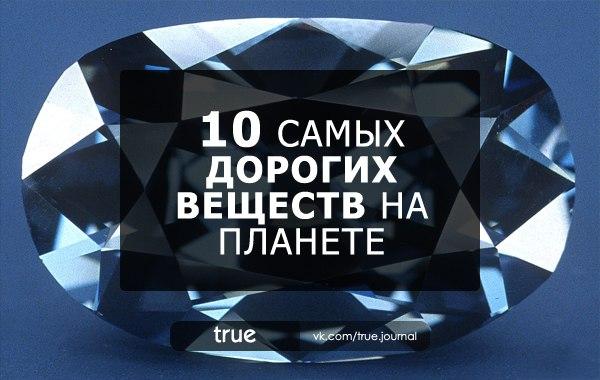10 most expensive substances in the world
 Bashny.Net
Bashny.Net

That in this world the most expensive? It turns out, not gold or platinum (them though and believe troy ounces, the price per gram of precious metals is not too high, depending on the fluctuations of the global rate of gold, on average, will cost $ 39, and platinum - $ 53). We have compiled a list of the most expensive substances and compounds, and their price per gram.
1. Plutonium - $ 4000
As you know, humanity without this radioactive metal can no longer live. It was he who heats our homes, our cities and explode into space launches our missiles. That is widely used in the manufacture of nuclear weapons, nuclear fuel for nuclear reactors, and as a source of energy for spacecraft. Preparation of plutonium from uranium ore - it expensive, but necessary.
2. Soliris - $ 17,000
The most expensive medicine in the world that treats those who suffer from a rare immune disease - paroxysmal nocturnal hemoglobinuria (when red blood cells during the night destroyed), grams, of course not for sale. The course of a year is worth $ 409 500. Although such people in the world a little - a few tens of thousands, the income of the pharmaceutical company Alexion Pharmaceutical for the first year was more than $ 300 million.
3. Tritium - $ 30,000
Radioactive super-heavy hydrogen, is extremely popular in commercial use, for example, they cover arrows wrist (and not just hours) or is placed in a sealed key chains, so that the light in the dark, and you could see how much time, or find the keys, if the station ended plutonium and electricity cut off.
4. LSD - about $ 30,000
Lysergic acid diethylamide known psychoactive drug that sends a man into a colorful trip. Experiments with the expansion of consciousness were extremely popular during the hippie, just to use drugs in secret CIA experiments. Since before the 90th in the list of banned substances in Russia, he was not a member, then it's easy to buy.
5. Diamond - about $ 42,000
Best friend any girl, diamond - the hardest substance on earth is so many kinds and colors that determine the price is not easy. Of course, precious stones, as well as metals, grams not measure. For them has its own measure of weight - Carat: 0, 2 grams. The average price of a carat diamond transparent - $ 8000, blue is worth more expensive - about $ 9,500, yellow and pink - is cheaper, about $ 6,000.
6. California - $ 60,000
Another radioactive isotope was produced artificially in 1950, the University of California. With a title like, clear. Unlike plutonium, from which it is produced, using californium in quite peaceful, even, we'd say, humane. For radiotherapy of tumors. Well, in scientific experiments on nuclear fission.
7. Americium - $ 140,000
Another transplutonium metal with a very long half-life, which can be up to 8,000 years. This metal is extremely useful - equipment with americium-241 and is used for removal of electrostatic charges with plastics, plastic film and paper. It is located inside some smoke detectors (~ 0, 26 micrograms per detector).
8. regolith (lunar soil) - $ 442 500 (for 0, 6 g)
Regolith - is that not only covers the surface of the moon, but all atmosphereless planets. Let's say the same of Mars. But the moon - the closest planet to us, to which, in theory, can fly, let alone send back rovers can do so every week. What is in the regolith? Nothing remarkable: ilmenite, olivine, anorthite, pyroxene - all this can be found on Earth. However, in 1993 at an auction Sotbi'c three "lunar pebble" total weight of 0, 6, c, brought to our planet more research Soviet shuttle, sold for $ 442 500.
9. Graphene - $ 100 million (per sq. Cm)
The invention is authored by Konstantin Novoselov, is difficult to measure in grams, because it weighs almost nothing. So it has to be measured in centimeters. Two-dimensional allotropic modification of carbon, a million times thinner than the thinnest human hair. Based on graphene can collect ballistic transistor used in supercapacitors for rechargeable power sources and manufacturing LEDs.
10. Antimatter - $ 62 trillion
In ordinary matter little negative particle rotates around a positively charged heavy nucleus (electron around the proton in the simplest case). And in the antimatter opposite - positive particle (positron) revolves around a heavy negative particle (antiproton example). When antimatter collide with ordinary matter is usually proton and antiproton annihilation of the electron and the positron, with the release of energy and the formation of gamma-ray photons. Now studying antimatter, however, the matter further small explosions does not go, due to the fact that you can not yet create a buffer zone, which would have got on antimatter and matter. But as soon as scientists get it, they immediately tell us, how did our universe and all of us put together.
Tags
See also
Interesting facts about most expensive food
The most expensive fish in the world
The most expensive toilet paper in the world
The most expensive cats in the world
The most expensive paintings of the world
The most expensive in the world visa
Six of the most expensive antique cars in the world
7 most expensive ...
Ten of the world's most expensive Beers
Made in China: the most expensive porcelain in the world















